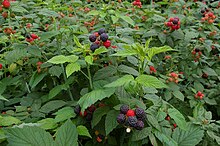Rubus coreanus
| Rubus coreanus | |
|---|---|

| |
| Scientific classification | |
| Kingdom: | Plantae |
| Clade: | Tracheophytes |
| Clade: | Angiosperms |
| Clade: | Eudicots |
| Clade: | Rosids |
| Order: | Rosales |
| Family: | Rosaceae |
| Genus: | Rubus |
| Species: | R. coreanus
|
| Binomial name | |
| Rubus coreanus Miq. 1867
| |
| Synonyms[1] | |
| |

Rubus coreanus, known as bokbunja[3] (Korean: 복분자), Korean blackberry,[3] or Korean bramble,[4] is a species of raspberry native to Korea, Japan, and China.[5] It produces edible berries (not true berries in the botanical sense) that are fermented into bokbunja ju (Korean: 복분자주), a Korean fruit wine (although the majority of fruit commercially grown for producing this drink are actually Rubus occidentalis, native to North America).[6][7][8][9] One of the biggest exporters of Bokbunja ju or Bokbonjajoo (depending on romanization) is the Bohae Brewery Company. The company launched high-quality traditional black Raspberry wine, Bohae Bokbonjajoo, back in 2004.[10] R. coreanus fruits are usually harvested between the months of May and July at peak harvest season. And can only be cultivated in a few areas in Korea, when compared to Rubus occidentalis, which can be cultivated widely across the country.[11]
Species Variations[]
Like every other fruit known to mankind, Rubus coreanus belongs to an incredibly extensive family of various fruit species with similar qualities. The extensive family of the aforementioned fruit is categorized under “Rubus.” The genus Rubus (family Rosacea) comprises 600 to 800 species distributed in a temperate climate and polar regions of the world. Fruits of Rubus species, commonly known as raspberries in Europe and the United States of America are largely distinguished by their color (red, black, and purple). Approximately 20 Rubus species are naturally found in Korea, including Rubus paroifolius, Rubus crataegifolius, Rubus corchorifolius, Rubus oldhamii, and Rubus coreanus.[11]
Health Benefits[]
Rubus coreanus has been used for centuries as traditional alternative medicine, as well as regular food, depending on its ripeness. Various studies have demonstrated that the ripe fruits of R. coreanus significantly reduce the risk of many diseases, including asthma, allergies, and obesity and are effective in reducing inflammation and oxidation.[12] They also exhibit antioxidative, antipyretic, anticancer, and anti-high cholesterol properties proving highly beneficial to human health.[11]
Antioxidant Properties and Extraction Methods[]
R. coreanus is rich in antioxidant compounds.[11] A major active compound in R. coreanus is ellagic acid, which has been shown to possess the anti-obesity and antioxidant properties the R. coreanus fruit is known for.[12] In order to extract the antioxidant properties, there are a couple of methods that can be employed. The most common methods of extraction for R. coreanus fruit and leaves alike are the conventional reflux heating or sonication extraction methods. Both methods share the same pre-preparation stage for samples before extraction. All samples are washed, dried in shade, and ground to a fine powder using a mill. In the reflux method, the ground powder is extracted using a Soxhlet extractor for three hours, with the extracts being filtered and concentrated using a rotary evaporator under a vacuum. In the ultrasonic bath extraction method, samples are extracted with 70% methanol using an ultrasonic bath at 64 °C for 2 h.[11]
See also[]
References[]
- ^ "The Plant List: A Working List of All Plant Species".
- ^ photo from Watson, William, Climbing plants Publisher: London [etc.] : T.C. & E.C. Jack Language
- ^ a b English Names for Korean Native Plants (PDF). Pocheon: Korea National Arboretum. 2015. p. 336. ISBN 978-89-97450-98-5. Archived from the original (PDF) on 25 May 2017. Retrieved 22 December 2016 – via Korea Forest Service.
- ^ BSBI List 2007 (xls). Botanical Society of Britain and Ireland. Archived from the original (xls) on 2015-06-26. Retrieved 2014-10-17.
- ^ "Rubus coreanus Miquel". Flora of China.
- ^ Eu, Gee-Suck; Chung, Byung-Yeoup; Bandopadhyay, Rajib; Yoo, Nam-Hee; Choi, Dong-Geun; Yun, Song-Joong (2008). "Phylogenic Relationships of Rubus Species Revealed by Randomly Amplified Polymorphic DNA Markers" (PDF). Journal of Crop Science and Biotechnology. 11 (1): 39–44.
- ^ Lee, Jungmin; Dossett, Michael; Finn, Chad E. (2014). "Mistaken Identity: Clarification of Rubus coreanus Miquel (Bokbunja)". Molecules. 19 (7): 10524–10533. doi:10.3390/molecules190710524. PMC 6271795. PMID 25045891.
- ^ Lee, Jungmin; Dossett, Michael; Finn, Chad E. (2013). "Anthocyanin fingerprinting of true bokbunja (Rubus coreanus Miq.)". Journal of Functional Foods. 5 (4): 1985–1990. doi:10.1016/j.jff.2013.06.006.
- ^ Lee, Jungmin (2015). "Analysis of bokbunja products show they contain Rubus occidentalis L. fruit". Journal of Functional Foods. 12: 144–149. doi:10.1016/j.jff.2014.11.005.
- ^ Bohae Brewery Co., (2021). Ltd MarketLine Company Profile. Retrieved from UMGC Library Database. URL: https://eds-p-ebscohostcom.ezproxy.umgc.edu/eds/detail/detail?vid=1 &sid=1a5a777b-0dd5-4325-a8df-2234f7654da8%40redis&bdata=JnNpdGU9Z WRzL WxpdmUmc2NvcGU9c2l0Z Q%3d%3d#AN=149250318&db=bth
- ^ a b c d e Lee, M. J., Nam, J. H., Jeong, J. H., Rho, R. I., (2020). Effect of Plant Part, Extraction Method, and Harvest Time over Antioxidant Yield of Rubus coreanus. Pharmacognosy Magazine, 16(5), 455-460. DOI: 10.4103/pm.pm_549_19
- ^ a b Oh, D., Kim, Y., Choi, E., Lee, H., Jung, M., Bae, D., Jo, A., Kim, Y. R., Kim, S., (2016). Antiobesity Effects of Unripe Rubus coreanus Miquel and Its Constituents: An In Vitro and In Vivo Characterization of the Underlying Mechanism. Hindawi Publishing Corporation, 1-15. DOI: 10.1155/2016/4357656
External links[]
- Rubus
- Flora of Eastern Asia
- Flora of China
- Berries
- Korean fruit
- Plants described in 1867
- Taxa named by Friedrich Anton Wilhelm Miquel